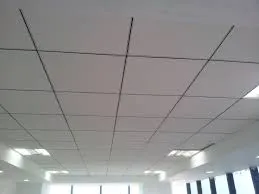- Afrikaans
- Albanian
- Amharic
- Arabic
- Armenian
- Azerbaijani
- Basque
- Belarusian
- Bengali
- Bosnian
- Bulgarian
- Catalan
- Cebuano
- Corsican
- Croatian
- Czech
- Danish
- Dutch
- English
- Esperanto
- Estonian
- French
- German
- Greek
- Hindi
- Indonesian
- irish
- Italian
- Japanese
- Korean
- Lao
- Malay
- Myanmar
- Norwegian
- Norwegian
- Polish
- Portuguese
- Romanian
- Russian
- Serbian
- Spanish
- Swedish
- Thai
- Turkish
- Ukrainian
- Uzbek
- Vietnamese
авг. . 06, 2024 14:56 Back to list
Exploring the Benefits and Applications of Mineral Fiber Ceiling Boards in Modern Construction
Exploring the Benefits and Applications of Mineral Fiber Ceiling Boards in Modern Construction
Understanding Mineral Fiber Ceiling Boards An Overview
Mineral fiber ceiling boards, a popular choice in modern construction and interior design, have gained significant traction due to their aesthetic appeal and functional benefits. These ceiling tiles are primarily made from a combination of inorganic mineral fibers, often including materials such as fiberglass and mineral wool, which provide a unique blend of sound absorption, thermal insulation, and fire resistance.
Composition and Manufacturing
Mineral fiber ceiling boards are manufactured from a mixture of natural and synthetic fibers, primarily derived from silica, gypsum, and various mineral compounds. The production process involves forming the fibers into mats, which are then compressed, dried, and cut into tiles. Some manufacturers may also add acoustic compounds to enhance sound absorption properties, making them suitable for commercial spaces, auditoriums, and offices where noise reduction is critical.
Aesthetic Versatility
One of the remarkable features of mineral fiber ceiling boards is their versatility in design. These tiles come in a variety of textures, sizes, and colors, allowing architects and designers to create visually appealing environments. From smooth, flat finishes to intricate patterns mimicking the look of plaster or wood, mineral fiber ceiling boards can complement any design theme. Moreover, they can be easily painted, enabling further customization to match specific color palettes or decor styles, which enhances their suitability for residential and commercial applications alike.
High quality Mineral Fiber Ceiling Tiles
Acoustic Performance
mineral fiber ceiling board

The sound-absorbing characteristics of mineral fiber ceiling boards are among their most significant benefits. These boards are designed to reduce noise levels in a space by absorbing sound waves, which limits echoes and reverberation. This makes them an ideal choice for areas such as classrooms, conference rooms, and healthcare facilities, where clear communication is essential. The Noise Reduction Coefficient (NRC) rating of these boards often falls between 0.5 to 0.9, indicating excellent sound absorption capabilities.
Fire Resistance and Safety
Safety is a paramount concern in building materials, and mineral fiber ceiling boards are engineered to withstand fire. Most mineral fiber products have a high fire resistance rating, often classified as Class A in accordance with the ASTM E84 standard. This means they do not contribute to the spread of flames and can provide valuable time during evacuations in the event of a fire. As a result, they are often favored in commercial buildings and public spaces where fire safety regulations are stringent.
Environmental Considerations
In an era where sustainability is increasingly important, mineral fiber ceiling boards also present environmental benefits. Many manufacturers are committed to producing eco-friendly products, with some tiles containing recycled materials. Additionally, the long lifespan and low maintenance requirements of these ceiling boards contribute to reduced resource consumption over time. Moreover, their natural insulation properties can lead to improved energy efficiency in buildings, helping to decrease overall energy costs.
Conclusion
In summary, mineral fiber ceiling boards are an excellent choice for a variety of applications, thanks to their impressive sound absorption, fire resistance, aesthetic flexibility, and environmental friendliness. Whether used in residential spaces or large commercial buildings, these ceiling tiles not only enhance the visual appeal of a room but also contribute significantly to the overall comfort and safety of the environment. As building design continues to evolve, mineral fiber ceiling boards will undoubtedly remain a key component in creating functional and stylish spaces.
-
Transform Interiors with PVC Gypsum Ceiling: A Stylish, Durable, and Moisture-Resistant SolutionNewsMay.19,2025
-
The Smart Interior Upgrade: Discover the Durability and Versatility of Gypsum Ceiling Access Panel SolutionsNewsMay.19,2025
-
The Smart Choice for Interior Design: Discover the Value of PVC Gypsum Ceiling SolutionsNewsMay.19,2025
-
Mineral Fiber Ceiling Tiles: The Smart Blend of Performance and AestheticsNewsMay.19,2025
-
Mineral Fiber Ceiling Tiles: The Superior Choice Over Gypsum for Sound and Fire SafetyNewsMay.19,2025
-
Mineral Fiber Ceiling Tiles: Eco-Friendly Strength and Style for Every CeilingNewsMay.19,2025








